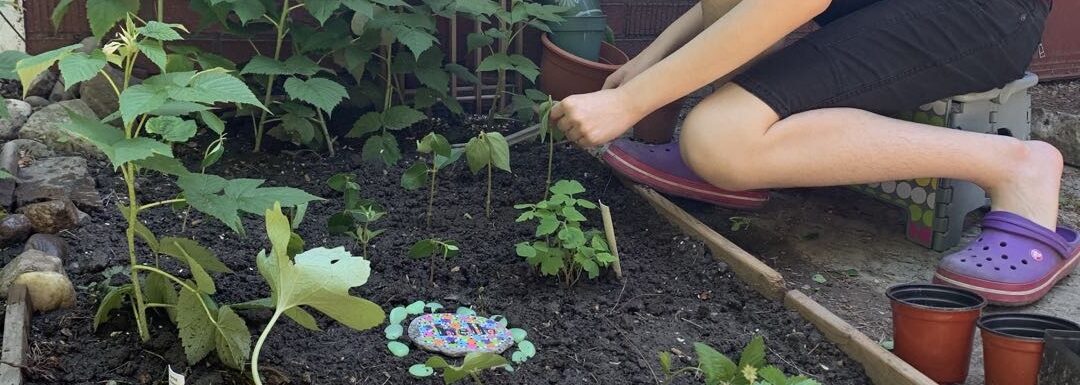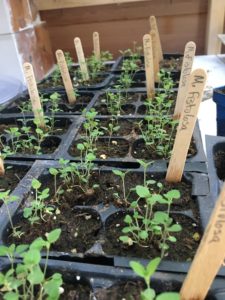“Bee the Change” Pollinator Project

Projects Sponsor
Pollinator habitat loss is, increasingly, a dire situation. “Bee the Change” is a smart, sweet response. With garden kits, education outreach, and propagating plants, “Bee the Change” has created roughly 100 m2 of habitat scattered across the Greater Toronto Area. While good for the bees, which is good for the planet, “Bee the Change” also helped build a sense of community for a school, one that defied pandemic-related isolation.
This means that, beyond the milkweed, “Bee the Change” is growing a whole new generation of climate leaders.

Growth of the Native Plant Wild bergamot (Monarda Fistulosa)
The “Bee the Change” program emerged from an idea first proposed by a University of Toronto Schools (UTS) student in early October, 2020. Loss of bee habitat means fewer and fewer bees. Fewer bees is leading to critical loss of biodiversity and ecosystem resilience, and of course bees also pollinate many food crops.
One student saw a simple, local way to help address that global issue, and the school ran with it, fast and far.
UTS had been looking for areas in which the school community could have a positive environmental impact. A pollinator garden on site would have been an ideal initiative: The garden would have provided a learning space as well as habitat. However, during online and hybrid classes, due to the COVID19 pandemic, and operating from a temporary location due to extensive school renovations, an in person, in class, in the ground UTS garden was impossible.
Fortunately the story didn’t end there. Instead the plot thickened, or at least it became many, many more plots.
The idea of DIY pollinator garden starter kits was hit upon and “Bee the Change” sprouted. Schooling was remote, and while that was a complication, by distributing 4-6 plants, plus seeds packets for 2-6 native perennials, the Bee team realised that acres of bee habitat could be restored across the GTA.
The goods, and the good they would do, were sent out in organic cotton bags. A competition, drawing from the school’s talent, provided a logo for the bags.
Although launched on a shoestring budget, a timely application led to full funding from the UTS Parents’ Association in October, 2020.
Over the following winter, extensive research was carried out, seedling plugs were ordered, seeds were bought and planting itself began in very early spring, as many native perennials require cold treatment in order to germinate.
During that first winter, volunteer ‘worker bees’ contributed to the “Bee the Change” database––which ideally will become part of their website––along with information, jokes and riddles.
In May and June of 2020, just as the team was supposed to be distributing their kits at school––there was another lockdown. While many participants (students, staff, and alumni) were able to come to the school for pickup, many others could not.
Teacher Elizabeth Straszynski––who grew all the stock at her home, including overwintering unused plants for use in the following year––drove across most of the GTA to deliver kits to participants who could not come themselves. Some kits included plants that would have made public transport not viable.
Volunteer sessions continued during the spring. The work has, so far, entailed about three hundred hours of student volunteer time to date, both virtual and in person, as lockdowns permitted. This has allowed for much engagement, learning and many leadership opportunities for UTS students.

Elizabeth Straszynski in Envirothon training video.
The “Bee the Change” project doubled their participant numbers in 2022, have a significant and still increasing stock of plants for special projects––the “wilding” of urban gardens being one example–– and they’ve expanded their species availability, including trees and shrubs for use in upcoming years.
Besides distributing ninety-eight kits in the last two years (equaling about a hundred square metres of newly cultivated bee habitat), the project has provided some 50 or so extra plants to individuals whose milkweed included a monarch larva (unplanned bonus!) or who needed supplies for a larger project (e.g. rewilding a lawn). In the spring of ’22 participants picked up plants from the school in person, while taking a moment to explore construction progress.
Beside the gardens––there was a reported >90% survival rate for plants distributed in 2021 based on returning participants’ surveys––the project also helped grow a sense of community at the school.
Students are learning both the practicalities of this program and pocket the process for projects down the road. This means that, beyond the milkweed, “Bee the Change” is growing a whole new generation of climate leaders













